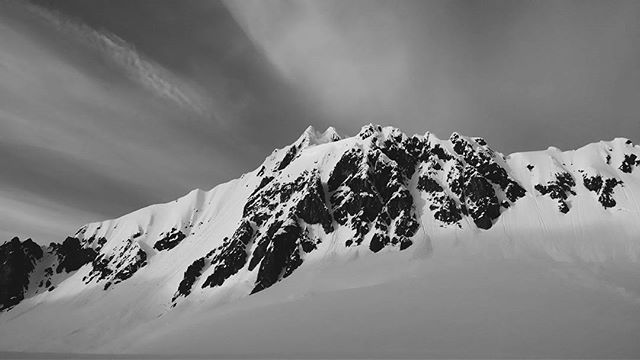We, Not I: A Story About Teamwork In The Mountains
- Madeline Cecilia
- May 6, 2016
- 4 min read
HAINES, ALASKA
We, Not I

Spring happened
The mountains are weeping
Tears, shedding like a waterfall
Shots go off in the distance
Rock and ice let loose from winter's frozen fingers
Some I see
Most I hear
Others I feel
The seasons are at war
Thunder roaring through my subconscious jolts me awake: its midday and I'm sleeping in a four walled canvas tent on a glacier in the Takhinsha Mountains just outside of Haines, Alaska. The sound of avalanches in the not so far distance is what lulled me to sleep in the first place. Although I knew the tent was a safe distance from any future debris field field, I was still nervous, laying in my sleeping bag masked from both the sun and the vista, that just maybe one of the slides could, would, roll through camp. The mixed rock and ice bombs continue to explode, one every 5 or 6 minutes, as I think about leaving my goose down feathered nest. The avalanching waterworks of falling snow from nearby peaks sparks a curiosity that drives me up onto my feet and out the zippered canvas flap. Its 6:00 pm and the sun is still high in the sky. Tim, one of the four members in our motley crew of, dare I say mountaineers, meets me at the door. He collects my vote, a yes- confirming group consensus, to escape the quickly melting mountains and fly back down to sea level: away from the white giants, mile long crevasse fields, and bergschrunds expanding by the moment.
The distance between the mountains protruding from an ice field can be incredibly deceiving. I realized this first hand on a midmorning excursion across the sahara desert, a.k.a. UV reflective glacial landscape, to ski a certain spine on a particular feature due west of camp. Exhaustion from the later estimated 14 mile traverse is not the only thing that shortened the day's trip. The run we had scouted an evening prior had experienced what appeared to be a cornice drop causing the skiable slope to slide. It's no coincidence that the pristine and natural quarter pipe of a run became a debris field. Spring had sprung and the mountains were falling apart, exploding even. Some slopes developed trails from rollerballs while others became dingy from rocks sliding; that is if the whole face hadn't already collapsed. We became the Snowtrekker gamblers placing bets on which run would slide next to pass the time before the sun began its decent and we could take another walk. If a slope avalanches and no one is there to hear it, does it really make a sound?
What I can attest to is that the elements were speaking to us, as they always do, and we were listening. We didn't embark on the journey only to scout lines and ski spines. We were there to observe, interact, and take notes. I had fictitiously registered myself in Avalanche 101: the trip of a lifetime. I realized first hand how important it is to open my senses and objectively observe the surroundings. The average daily temperature rose above 50 degrees Fahrenheit. The ground escalated to 8 degrees Celsius at 2:00 pm on day four, according to our snow thermometer. If we were to ski anything high angle, ice tools and an early start were necessary to avoid triggering a wet slide on the way down. The corn snow window was mere minutes. Being that the sun never fully set, that time frame was difficult to catch. It was hard to shut my eyes and leave consciousness when I was literally living beneath ribbons of pastel colors floating through the night's sky. I loved glacier life.
The environmental sociologist in me was enthralled. My favorite take away from being in the midst of an avalanche frenzy days in a row was the inability to escape the most primal aspects of myself. Every decision revolved around the community, all four of us, and our safety. From communal meals to roping up as we traversed crevasse fields, we, not I mattered most. It took a full day upon arriving back at sea level to retrain my mind not to mistake the sound of a passing car for an avalanche. The second time time this happened I giggled, went back to my business, and then the same car's engine only seconds later tricked me once more. An instinctual mountain mind emerges when we are in the wilderness: a more fundamental version of ourselves.
On day five, the social experiment came to an end and we were lifted off the glacier. Seeing our footprint from the mountain's eye view was a treat. The tracks from our tiny chartered bush plane were embedded in the ice; as were the indents of our foot steps from the tent to the kitchen and back, each dropped item, every shoveled out piece of terrain and, my favorite, our skin tracks, all of them into the abyss. Everything had been preserved, at least until the next big storm. We had experienced what we flew up to see, attempted to ski, and gained a little insight into the do's and dont's of spring glacial travel in southeast Alaska. It doesn't amaze me that I have been on skis for over 1,000 days in my lifetime and am still learning. The more information I glean about weather, snowpacks, and decision making, the more I realize I have so much left to absorb about the avalanche phenomenon. Sometimes, I am afraid of what I don't understand but am realizing that is in fact is one of life's greatest beauties: the known unknown.








Comments